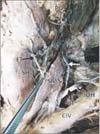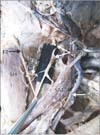Abstract
Though anomalies of the superior belly of the omohyoid have been described in medical literature, absence of superior belly of omohyoid is rarely reported. Herein, we report a rare case of unilateral absence of muscular part of superior belly of omohyoid. During laboratory dissections for medical undergraduate students, unusual morphology of the superior belly of the omohyoid muscle has been observed in formalin embalmed male cadaver of South Indian origin. The muscular part of the superior belly of the omohyoid was completely absent. The inferior belly originated normally from the upper border of scapula, and continued with a fibrous tendon which ran vertically lateral to sternohyoid muscle and finally attached to the lower border of the body of hyoid bone. The fibrous tendon was about 1 mm thick and received a nerve supply form the superior root of the ansa cervicalis. As omohyoid mucle is used to achieve the reconstruction of the laryngeal muscles and bowed vocal folds, the knowledge of the possible anomalies of the omohyoid muscle is important during neck surgeries.
Omohyoid (OH) muscle is one of the infrahyoid muscles that consist of superior and inferior bellies. The two bellies are continuous to each other at the intermediate tendon. Inferior belly takes origin form the superior border of the scapula, close to the suprascapular notch. It runs across the lower part of the posterior triangle, and then continues with the intermediate tendon behind the sternocleidomastoid muscle. Superior belly begins from the intermediate tendon, and then runs vertically to across the anterior triangle to get inserted to the lower border of the hyoid bone, close to the insertion of the strnohyoid muscle [1]. Unusual origin, insertion, multiple bellies, absence and adhesion to sternohyoid are the reported anomalies of the superior belly of the OH [2]. In the present case, we report a rare case of superior belly of OH and discuss its clinical relevance.
During regular dissections for medical undergraduate students, we came across a rare anatomical variation of the superior belly of OH. It was observed in a 65-year-old cadaver from Southern India. Observed variation was unilateral and found on the left side of the neck. The inferior belly as usual took origin from the upper border of the scapula, close to the suprascapular notch. Then, it ran across the posterior triangle obliquely and continued as a thick fibrous tendon underneath the sternocleidomastoid muscle. Further, this fibrous tendon ran vertically lateral to the sternohyoid muscle and finally attached to the lower border of the hyoid bone, close to the insertion of the sternohyoid muscle. The muscular part of the superior belly of OH was completely absent. Fibrous band was about 1 mm broad and received a nerve twig from the superior root of the ansa cervicalis (Figs. 1, 2).
Previously authors have described the anomalies of the superior belly of OH. A case of the unusual attachment of superior belly of OH to the transverse process of C6, close to the scalenus medius has been reported [3]. Absence of inferior belly of OH associated with the unusual attachment of the superior belly to clavicle has been observed [4]. Miura et al. [5] have observed a duplicated superior belly of the OH. Anderson [6] has observed unilateral duplicated superior and inferior bellies. Wood [7] has reported the triplication of superior belly and insertion of superior belly to the thyroid cartilage. Tamega et al. [8] have reported the absence of muscular part of superior belly of OH. Inferior belly continued with about 2.5 mm broad tendon, which was inserted to the hyoid bone. Our case is similar to previous finding, but the observed tendon was thin and received a nerve twig from the ansa cervicalis.
Sukekawa and Itoh [2] have studied the intermediate morphologies between normal and anomalous morphologies of the superior belly of OH. They classified the intermediate morphologies into four types; type 1 with unclear anterior margin of the superior belly due to the poor myofiber development; in type 2, the superior belly was composed of a posterior large belly and an anterior small belly; in type 3, superior belly composed of three to five bellies and the bellies were arranged in a roof tile-like morphology; in type 4, the superior belly was found to consist of two bellies arranged parallel to each other in anterior-posterior direction [2]. in the present case, we observed a rare morphology of the superior belly of OH where its muscular part is replaced by a thin fibrous tendon, on the left side of the neck.
All the infrahyoid muscles develop from the muscle primordium in the anterior cervical area [9]. Initially, the muscle primordium divides into a shallow layer and a deep layer. The deep layer forms the sternothyroid and thyrohyoid muscles. The shallow layer of the primordium forms the splenius which spread in the cervical region. Then, the splenius divides into the internal and external muscles. The internal muscle develops into sternohyoid muscle whereas the lower part of the external muscle becomes the OH muscle [9]. The absence of the muscular part of the superior belly could be related to the complex primitive morphology of the splenius.
OH muscle flap is used to repair the laryngeal muscles [10] and for treatment of the bowed vocal folds [11]. It is also used for the vocal cord abduction restoration [12]. Krishnan et al. [13] have described that OH is the reliable landmark for the endoscopic exploration of the brachial plexus. The knowledge of the possible anomalies of the OH muscle is important to head and neck surgeons during the surgical procedures involving the anterior cervical region. Occurrence of absence of the muscular part of the superior belly with presence of a fibrous tendon lying in its position is seldom reported in the literature. Nevertheless the fibrous tendon receiving the nerve supply from the ansa cervicalis has never been documented.
Figures and Tables
 | Fig. 1Dissection of anterior triangle of the left side neck showing the absence of muscular part of the superior belly of omohyoid and presence of fibrous tendon (FT) in its position. ClV, clavicle; EJV, external jugular vein; IOH, inferior belly of omohyoid; IT, intermediate tendon; SH, sternohyoid muscle; SM, sternocleidomastoid muscle. |
 | Fig. 2Dissection of anterior triangle of the left side neck showing the absence of muscular part of the superior belly of omohyoid and presence of fibrous tendon (FT) in its position. Note the nerve twig supplying the fibrous tendon (NFT). ANS, ansa cervicalis; EJV, external jugular vein; SH, sternohyoid muscle; SM, sternocleidomastoid muscle. |
References
1. Standring S. Gray's anatomy: the anatomical basis of clinical practice. 39th ed. Edinburgh: Churchill and Livingstone;2005. p. 538–539.
2. Sukekawa R, Itoh I. Anatomical study of the human omohyoid muscle: regarding intermediate morphologies between normal and anomalous morphologies of the superior belly. Anat Sci Int. 2006; 81:107–114.
3. Tubbs RS, Salter EG, Oakes WJ. Unusual origin of the omohyoid muscle. Clin Anat. 2004; 17:578–582.
4. Bolla SR, Nayak S, Vollala VR, Rao M, Rodrigues V. Cleidohyoideus: a case report. Indian J Pract Dr. 2007; 3:1–2.
5. Miura M, Kato S, Itonaga I, Usui T. The double omohyoid muscle in humans: report of one case and review of the literature. Okajimas Folia Anat Jpn. 1995; 72:81–97.
6. Anderson RJ. The morphology of the omohyoid muscle. J Med Sci. 1881; 10:1–17.
7. Wood J. Additional varieties in human myology. Proc R Soc Lond. 1865; 14:379–392.
8. Tamega OJ, Garcia PJ, Soares JC, Zorzetto NL. About a case of absence of the superior belly of the omohyoid muscle. Anat Anz. 1983; 154:39–42.
9. Lewis WH. The development of the muscular system. In : Keibel F, Mall FP, editors. Manual of Human Embryology. Philadelphia: Lippincott;1910. p. 454–522.
10. Song J, Wang Q, Wang X, Qu Y, Qin Z, Li J, Wang P, Zhang J. Study on post-laryngectomy partial laryngeal defect repaired with omohyoid myofascial flap. Lin Chuang Er Bi Yan Hou Ke Za Zhi. 2003; 17:519–521.
11. Kojima H, Hirano S, Shoji K, Omori K, Honjo I. Omohyoid muscle transposition for the treatment of bowed vocal fold. Ann Otol Rhinol Laryngol. 1996; 105:536–540.
12. Crumley RL. Muscle transfer for laryngeal paralysis: restoration of inspiratory vocal cord abduction by phrenic-omohyoid transfer. Arch Otolaryngol Head Neck Surg. 1991; 117:1113–1117.
13. Krishnan KG, Pinzer T, Reber F, Schackert G. Endoscopic exploration of the brachial plexus: technique and topographic anatomy: a study in fresh human cadavers. Neurosurgery. 2004; 54:401–408.




 PDF
PDF ePub
ePub Citation
Citation Print
Print


 XML Download
XML Download